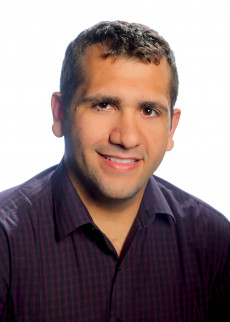Berkeley Lab 2016 Alvarez Fellow: Matthew Zahr
October 15, 2016
As Berkeley Lab’s 2016 Alvarez Fellow, Matthew Zahr will be developing efficient, projection-based methods for solving optimization problems constrained by partial differential equations in the Computational Research Division (CRD) Math group.
“I am interested in further developing these methods to address some of the problems of interest at Berkeley Lab, such as those in combustion and material science,” says Zahr. “I’m also developing new methods for resolving shocks in compressible conservation laws, topological optimization and solving problems with multiple spatial scales.”
Before joining Berkeley Lab as an Alvarez Fellow, Zahr was a Department of Energy Computational Science Graduate Fellow (CSGF) pursuing his Ph.D. in Computational and Mathematical Engineering at Stanford University. Upon meeting Berkley Lab Mathematician Dan Martin at the annual CSGF meeting, Zahr decided to spend the summer after his first year of graduate school at the Lab.
That summer, he worked with Berkeley Lab’s Per-Olof Persson on high-order Discontinuous Galerkin (DG) Methods for Computational Fluid Dynamics (CFD). Over the next few years he continued to work with Persson and others in Berkeley Lab’s Mathematics Group, including Jon Wilkening, on projects that were a cross-over between his thesis research—efficient Partial Differential Equation (PDE) constrained optimization—and their main research directions—high-order DG methods and time-periodic solutions of PDE. As a CSGF fellow, he also took advantage of opportunities to collaborate with researchers at other DOE National Labs, like the Sandia National Labs in California and New Mexico, which allowed him to expand into the field of uncertainty quantification.
Before Stanford, Zahr was an undergraduate student at UC Berkeley pursuing a Bachelors degree in Civil and Environmental Engineering. The summer before graduation, he participated in the Army High Performance Computing Research Center’s (AHPCRC) Summer Institute where he worked on a computational mechanics research project with a professor and his graduate students. He enjoyed the experience so much that he spent his last year at UC Berkeley strengthening his math skills, and then decided to do his graduate work in the applied/computational math program at Stanford specifically to work with the professor from his AHPCRC program.
Originally from Modesto, California, Zahr likes to hike, lift weights, run and swim in his free time. In winter, he enjoys skiing and snow camping in Tahoe.
About Berkeley Lab
Founded in 1931 on the belief that the biggest scientific challenges are best addressed by teams, Lawrence Berkeley National Laboratory and its scientists have been recognized with 16 Nobel Prizes. Today, Berkeley Lab researchers develop sustainable energy and environmental solutions, create useful new materials, advance the frontiers of computing, and probe the mysteries of life, matter, and the universe. Scientists from around the world rely on the Lab’s facilities for their own discovery science. Berkeley Lab is a multiprogram national laboratory, managed by the University of California for the U.S. Department of Energy’s Office of Science.
DOE’s Office of Science is the single largest supporter of basic research in the physical sciences in the United States, and is working to address some of the most pressing challenges of our time. For more information, please visit energy.gov/science.










